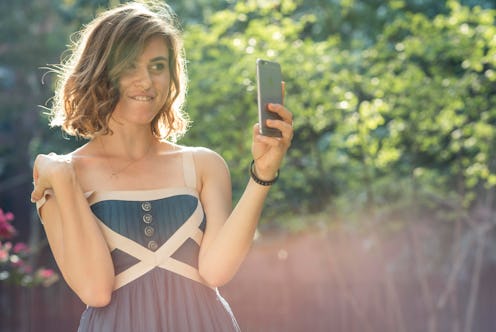Fashion
How To Take A Good Selfie, According To Science

It's the question tormenting an entire generation: How do you take a good selfie? The Kardashians may make it look easy, but the actual practice of the modern self-portrait requires the perfect mix of forethought, lighting, and an ability to look surprised at the fact that you're taking a picture of yourself. Duck face is so last year, y'all — 2015 was the year of faux-astonishment. Who knows what the future will bring?
And yet, even when the stars align and you feel like you've taken the best selfie in the universe, there are times when our favorite pictures of ourselves fall flat. You happily upload that selfie of your new hair color, or on top of a mountain to show how ~adventurous~ you are, or making a face in line at the coffee shop, fully expecting hundreds of likes and the beginning of your career as an Instagram guru, but by the end of the day you've only racked up a paltry seven likes. Your mom gets more than that. So what gives? What makes one selfie better than the other?
These are the questions asked by Stanford PhD candidate Andrej Karpathy, who trained an artificial intelligence system to determine what makes a "good" selfie — and, by extension, what makes a "bad" one. You know, the kind that makes you question your entire appearance.
Known as the "140-million-parameter state-of-the-art Convolutional Neural Network," or ConvNets for short, the system sifted through more than two million selfies to calculate which got the most likes in proportion to the size of their audience. Karpathy lays out the technical details here, if you're interested, but it boils down to this: First, he trained the AI system to know the difference between a "good" and "bad" selfie, then he set it loose on 50,000 selfies it hadn't seen before. Once those images were sorted into either category, Karpathy took the top results and analyzed trends apparent in the data.
But enough technical speak. What trends did Karpathy find in the best selfies?
1. Women Get More Likes
Female selfies consistently got more likes than male; in fact, there weren't any men in the top 100 at all. Interestingly enough, men actually had slightly different rules for selfie-taking than women — Karpathy manually analyzed the top male selfies, and he found gender differences that I'll note as we go along.
2. Position Your Face In The Top 1/3.
As Karpathy points out, the trend in framing the selfie is apparent at a glance. Faces should occupy the center of the first third of the image, and they're frequently tilted as well.
3. Cut Off Your Forehead
Yup, you read that right — selfies featuring women whose foreheads were slightly out of frame were more popular. Men, on the other hand, were more popular when their faces and shoulders were fully visible.
4. Show Off Long Hair
Again, this only applies to women; male selfies were more popular if they featured the pompadour look that's been so popular recently.
5. Filter. Filter Like Crazy
Karpathy noted that oversaturated selfies were more popular, possibly because they give skin a more even tone, and the top selfies were filtered more often than not. That being said, don't go crazy with Lo-Fi; the filters tended to decrease contrast.
6. Add A Border
Weirdly enough, borders were also present in most of the popular selfies. Who knew? Karpathy also noted that there were some trends in the less popular selfies: Poor lighting, uncomfortable close-ups, and group selfies. Sorry, everyone, but nobody cares about group selfies unless they feature Ellen DeGeneres and a bunch of A-list Oscar nominees.
That being said, it's important to remember that these are merely guidelines, not rules to live your life by. If you want to take a group selfie, go ahead! Do the amount of Instagram likes really matter more than how much fun you were having? I didn't think so. Happy selfie-taking!
Images: Andrew Zaeh/Bustle; Giphy (8)